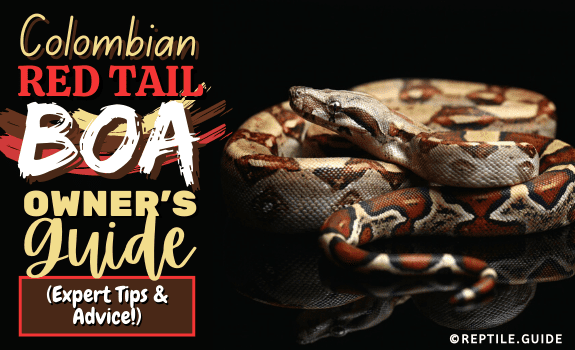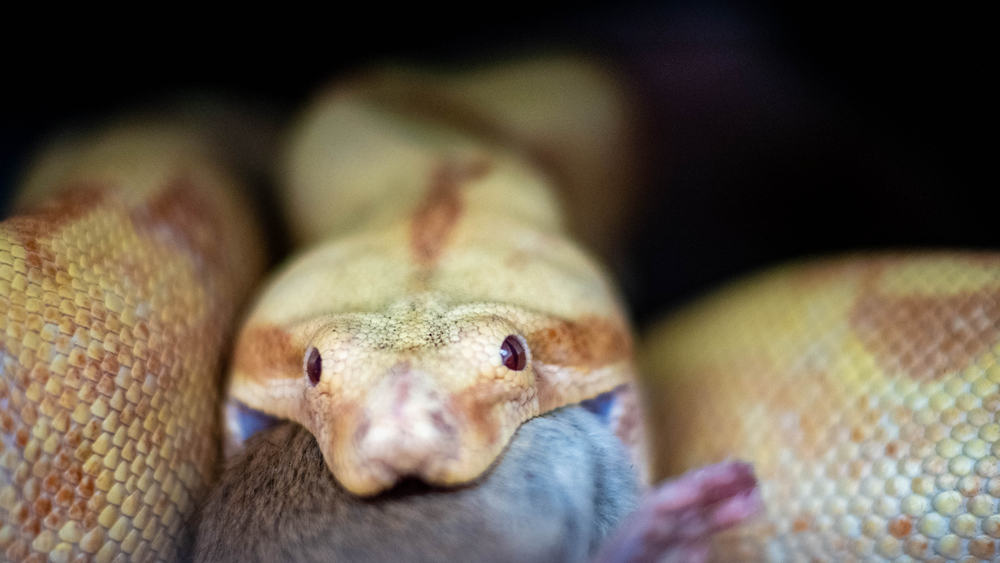The Colombian red tail boa is a large constrictor with a docile temperament.
We DON’T recommend these snakes for beginner snake owners.
A full-grown Colombian red tail boa can injure you by constricting around your arm or mistaking your hand for food.
It’s best to have some snake-keeping experience before getting one of these snakes.
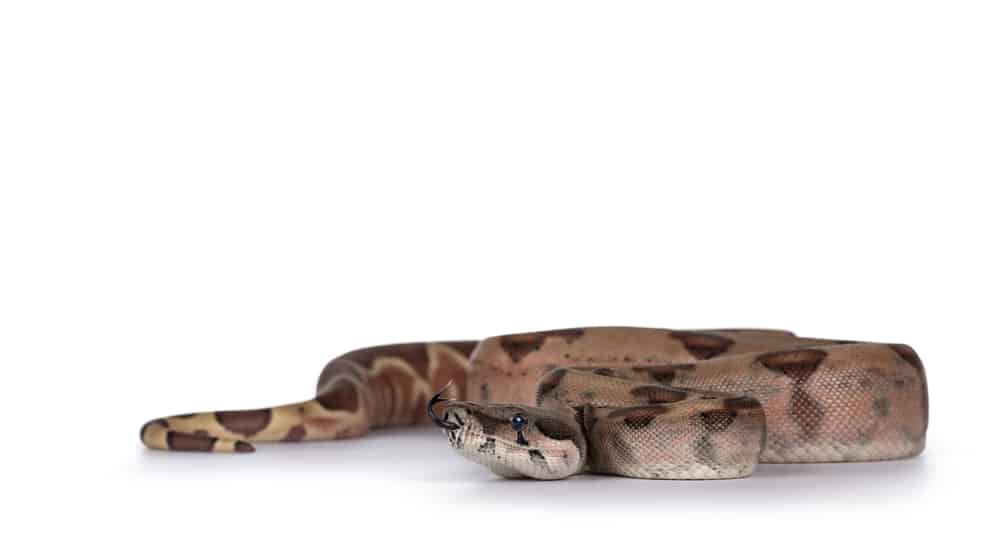
In This Article
Before You Buy a Colombian Red Tail Boa
Before buying a Colombian Boa imperator, you need to consider a few things:
| Size |
Young boa constrictors reach five feet within a year. You’ll need to rehouse your new pet two or three times during the first year. Young constrictors can easily get lost or stressed in a tank that’s too big. This can even lead to them dying from a lack of warmth (on the cool side of the enclosure). This boa species can be hard to handle if you’re not used to handling large constrictors. |
| Temperament |
While these animals are docile, they can mistake you for food. Their sharp, jagged teeth and large size mean that an angry Boa constrictor can leave a nasty wound. You need experience with:
If you can do all these things, then you can consider getting one of these snakes. |
| Cost of maintenance |
The Colombian red tail boa constrictor is a large animal with a matching appetite. Feeding them as much as they need may become a minor financial drain. Feeding a large Colombian red tail three guinea pigs a month can cost in excess of $50 a month. Replacing the substrate every two weeks can add as much as $100 to your monthly tally. Buying new UVB bulbs every four months is another $80-100. You can easily spend over $800 every four months, just for the basics. |
| Maintenance difficulty |
If you want a pet that’s easy to take care of, then a Boa constrictor is the wrong choice. Big animals that eat big meals produce a lot of feces. The Colombian red tail boa size means that cleaning their enclosure is a lot more challenging than it would be with a small snake. |
Colombian Boa Constrictor Price
Colombian red tail boas vary in price depending on the morphs involved.
You can expect to pay between $200 and $250 for a standard morph.
Rare Colombian red tail boa morphs like the Aztec motley can cost almost $2,000.
Where to Buy a Colombian Red Tail Boa
As the smaller subspecies of Boa constrictor, these animals are popular.
The best places to buy captive-bred animals include:
- Repticon – Reptile conventions host vetted breeders from around the country. You’re sure to find quality animals at excellent prices.
- Online marketplaces – One of the most convenient ways to buy. Sites like MorphMarket screen the breeders so you don’t have to. Animals get delivered to your door.
- Directly from the breeder – Many trusted breeders sell animals through their websites, or local forums.
You can often find excellent animals this way at wonderful prices. If you’re unsure about a breeder, ask on your local reptile forums.
Someone is bound to have experience with them.
We don’t recommend buying boas from pet stores, since you don’t know the background of the animal. You also don’t have a guarantee that it’s captive-bred.
Are Colombian Red Tail Boas Aggressive?
Colombian red tail boas aren’t generally aggressive.
These animals have a very laid-back approach to life, but any snake has a temper, especially when getting ready to shed.
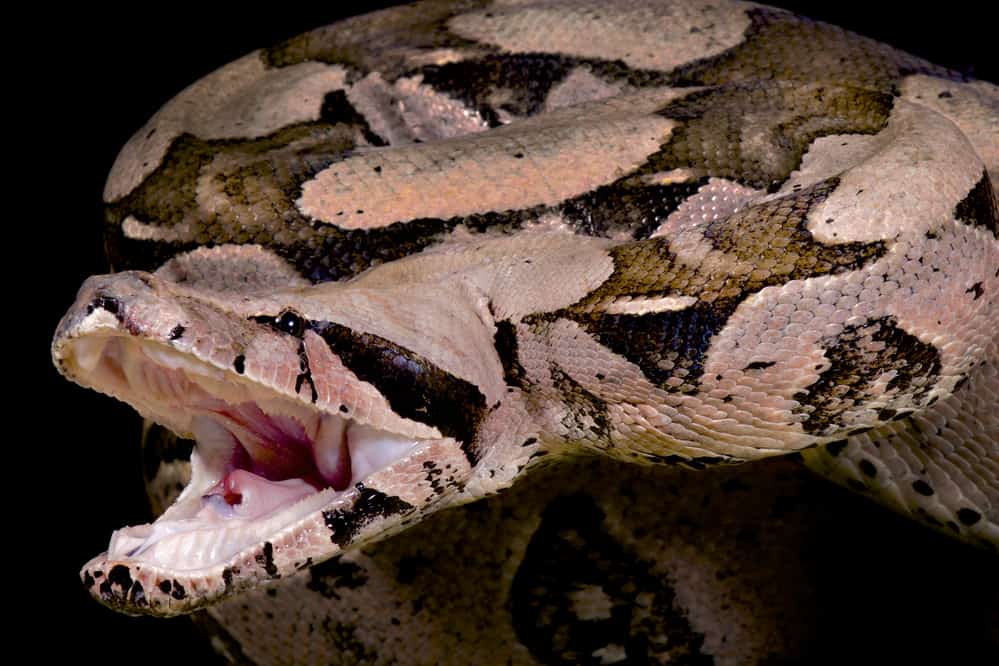
These snakes smell their prey, rather than hunting by sight, and can easily mistake you for food.
If it’s having a bad day or mistakes you for a meal, a Colombian red tail can inflict damage.
While these snakes are docile by nature, we don’t recommend getting one if you have no experience with other large snakes.
How Big Do Colombian Red Tail Boas Get?
Colombian red-tailed boas are medium-large snakes.
Females have average lengths of seven to nine feet.
Males are shorter, averaging at six to eight feet.
A baby Colombian red tail boa emerges from its egg with a length of 20 inches but can reach lengths of five feet or more within a year.
How Do Colombian Boa Constrictors Differ From Other Boa Constrictors?
There are few differences between the red-tailed boa and other boa constrictors.
Colombian red-tails are smaller than their relatives. They also have darker tails.
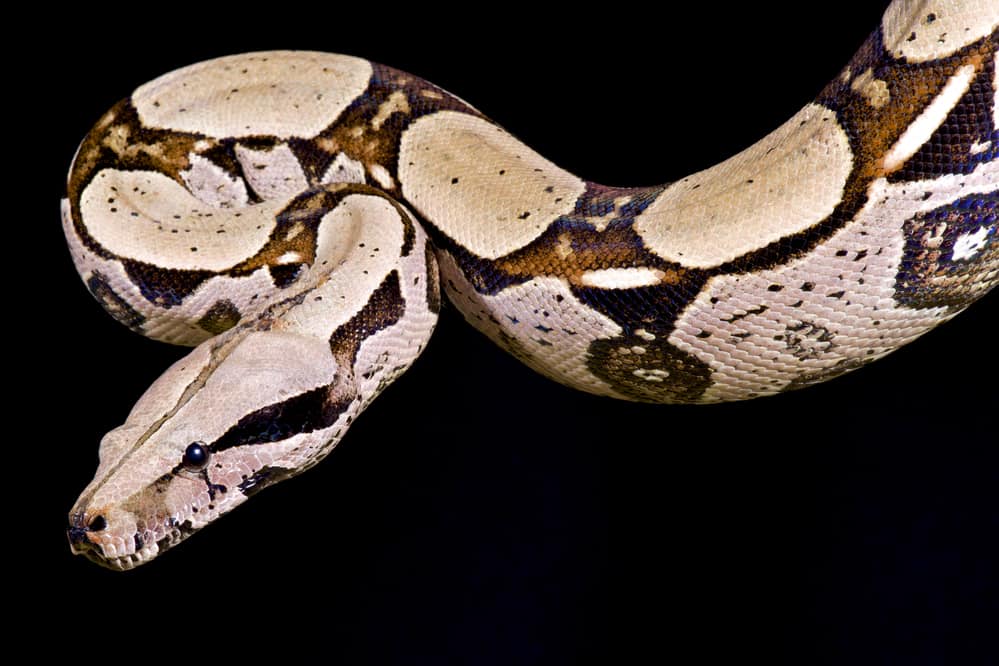
The original red tail boa, Boa constrictor, and the Colombian red tail boa, Boa imperator, have different ranges:
- The red-tailed boa occurs in both Central and South America, but more South America.
- The Colombian red tail boa is sometimes called the Central American boa since its range focuses on Central America.
In temperament, feeding habits, and habitat preferences, the species are otherwise similar.
Colombian Red-Tailed Boa Size and Appearance
The Colombian red tail boa, Boa constrictor imperator or Boa imperator, reaches average lengths of between seven and nine feet.
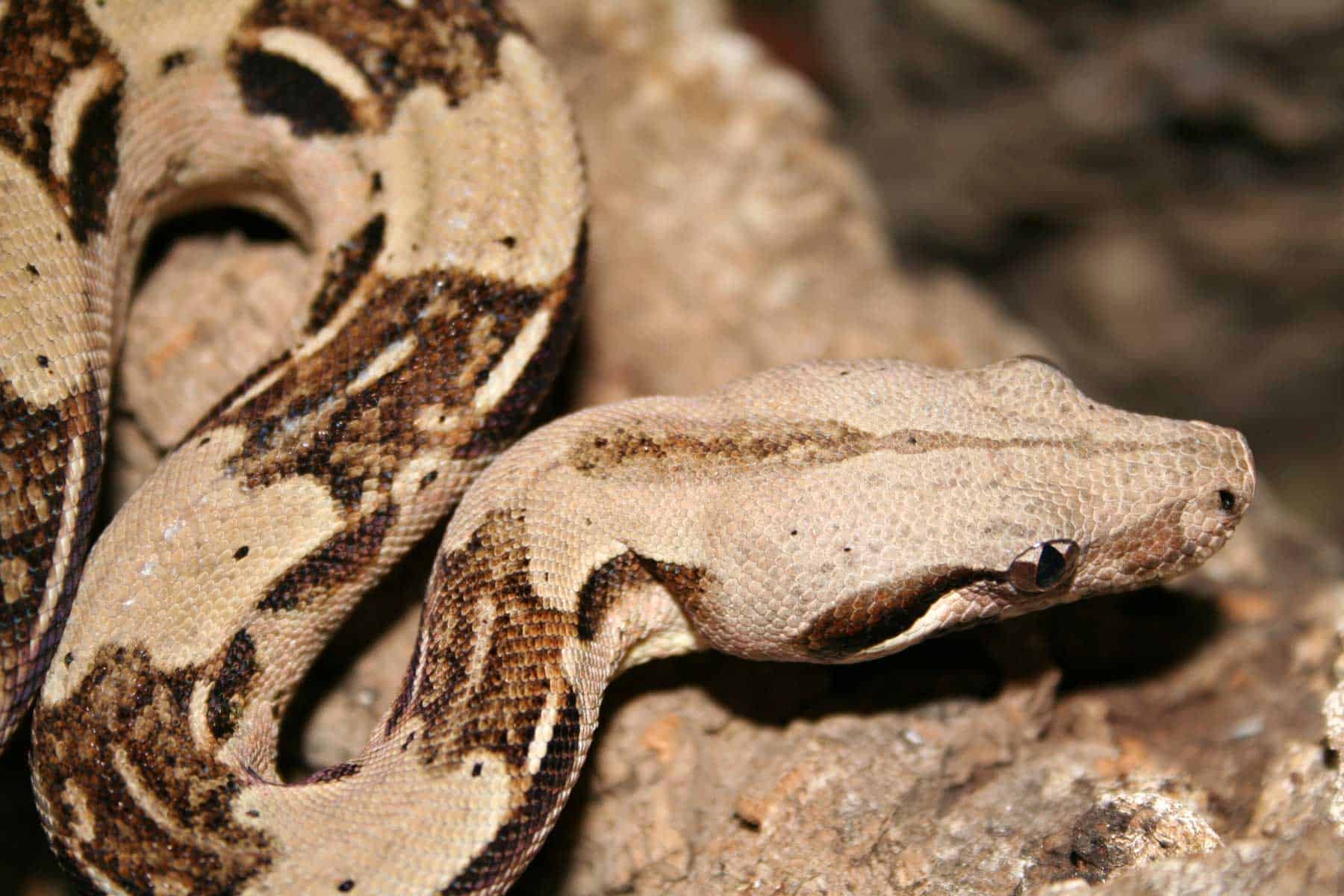
Colombian red tail boas are a Boa constrictor subspecies: Boa constrictor imperator.
In 2009, scientists proposed to officially make the Colombian red-tailed boa a full species, as opposed to a subspecies. This was thanks to the differences in appearance and habits.
The Colombian red-tailed boa tends to be smaller than the related Boa constrictor. In extreme cases, the red tail boa may reach up to 12 feet in length.
The Colombian red tail boa rarely exceeds eight feet in length. It also has a darker tail than other red tail boas.
Colombian red tail boas have similar patterns to other Boa constrictors. It’s a leopard-like pattern featuring a dark outline with lighter centers.
The general background color of this species is a sort of light tan-fawn. The overlying markings are darker brown with a caramel-brown interior.
Both Boa constrictors and Colombian red-tailed boas have broad heads typical of constrictors.
This accommodates their ability to dislocate their jaws and eat prey larger than their heads.
They have a row of labial pits which they use to sense prey and a sharp nose. This gives their heads an almost triangular appearance.
Colombian Red Tail Boa Lifespan
Colombian red tail boas live for around 20-30 years in the wild. It’s not unusual for young snakes raised in captivity to live for more than 40 years.
The Colombian red tail boa lifespan depends on various factors, including:
- Medical care
- Quality of diet
- Exposure to stress
- Exposure to parasites and diseases
- Predator pressure, and exposure to natural disasters
Fun Fact: According to the IUCN, wild Colombian Boa constrictors have a generation length of 16 years. This means that a red tail boa is 16 years old before its children have children.
Colombian Red Tail Boa Enclosure Setup
As we mentioned earlier, these animals reach large sizes and need a matching enclosure:
- Young boas (a foot or less long) can live in a 15-gallon enclosure.
- Juveniles (two to five feet long) need a 90-gallon enclosure or larger.
- Adult boas (six to eight feet long) need at least a 250-gallon aquarium.
You’ll need to replace any Colombian red tail boa enclosure as the snake grows, and it can go from needing a 15-gallon to a 90-gallon in the space of a year.
Starting a small snake in a large enclosure will lead to issues with feeding, and a stressed-out snake.
Hatchlings easily get lost and may struggle to find their way back to the basking area.
Like most boas, the red tail is an escape artist. You need to ensure that a Colombian red tail boa tank setup is 100% escape-proof.
To avoid escapes, ensure that:
- All ventilation has a tight-fitting mesh cover
- Any equipment ports or cable slots have a silicone plug or mesh cover
- There’s a sturdy grid over the enclosure, and beneath the lid.
- It’s better to make small holes in the grid for equipment that needs to be inside the enclosure, than to have a snake escape.
Substrate
The right substrate for your boa:
- Facilitates cleaning
- Makes the snake feel secure
- Contributes toward humidity levels
These animals sometimes have burrowing tendencies. Ensure that you give the enclosure at least two to three inches of substrate.
We’ve linked to some of the products we trust and recommend. Some of the best options include:
|
Coconut peat is one of the best naturalistic substrates out there. It’s a byproduct of the coconut food industry, which means it’s sustainable (unlike peat moss). It’s affordable, easy to spot clean, and does a great job at keeping humidity levels high. |
|
|
|
Orchid bark is an excellent substrate for larger boas. It’s effective at maintaining humidity, and you can use it over coco peat or aspen shaving base layer if you need higher humidity. It’s also inexpensive, easy to get hold of, and sustainable. |
|
Aspen shavings are one of the most popular substrate options for common boa species. It’s affordable, easy to use, and excellent at maintaining humidity. NEVER use other aromatic woods, like pine. They contain oils that can have devastating effects on your snake’s skin. |
|
|
Sphagnum moss is one of the best bedding options for maintaining humidity. While it can be expensive on its own, it makes a wonderful addition to substrate blends. It’s also useful as bedding inside the hide box. |
You don’t need to use a single type of substrate. Combining substrates is a valid option, and might give your snake something it prefers over any single option.
Temperature and Humidity
The Colombian subspecies of this snake come from the tropical regions of Central America and Mexico. It has high temperature and humidity needs.
As with any snake, you should provide a temperature gradient. Reptiles have no internal control over their body temperatures.
They need to have different temperature zones in their enclosure, so they can move around to adjust their body temperatures.
This is easy to do by heating only one-half of the enclosure. Try to maintain these temperatures in your boa constrictor enclosure:
- Cool end: Around 78°F
- Basking spot: 95 to 100°F
- Ambient temperature: 80 to 85°F
- Nighttime temperature: 70 to 80°F
Aim to maintain a relative humidity of 60-80% at all times. Inappropriate humidity levels can lead to respiratory infections.
You can increase humidity levels by using a large water bowl and misting the substrate. If you still struggle, consider using a reptile humidifier.
Monitoring the temperature and humidity is essential. We recommend having a thermometer-hygrometer combo on each side of the enclosure.
It will allow you to track the warm and cool end of the enclosure and humidity throughout.
Heating and Lighting
You have several different options when it comes to heating and lighting the enclosure.
If you’re looking for a reliable snake food and supplies online store, we recommend Chewy! It is the most trusted and convenient online destination for reptile pet owners.
Click here to save 30% on your first order. We may receive a small commission if you purchase after clicking.
This does NOT change what you pay or what I recommend. It does help fund the research we put into the site, and I’m grateful for any support!
We’ll also leave links to our favorite Amazon products in each category, so that you can choose which site to use.
You can consider the following heating options:
| Heat lamps |
Excellent options for keeping temperatures in the appropriate range during daylight hours. When combined with a full-spectrum bulb, it can provide both a day-night light cycle and daytime heating. |
|
Under-tank heating is an excellent choice for round-the-clock temperature management. It won’t affect the snake’s activity times since it doesn’t produce light. You can also connect the heating pad to a thermostat and timer to produce cooler temperatures at night than during the day. |
|
|
These devices create heat without producing light. They’re an excellent option for keeping temperatures in range at night, or if you’d like separate heating and lighting systems. |
Using heat lamps and ceramic heat emitters is the most natural way of giving your snake heat.
In the wild, these animals would get heat from above rather than below. If you do use heating lamps, use a lamp guard to ensure that your snake can’t burn.
These boas are nocturnal and don’t need UVB lighting. However, UVB might help your snake stay healthier.
Your snake needs lighting to give it a day and night cycle. Since they’re nocturnal, Colombian red tail boas need a set daytime and nighttime.
If they don’t have a lighting schedule, it will interfere with their health and may even cause premature death.
If you’re using heat lamps, you won’t need to provide extra lighting. If you’re not using heat lamps, a simple full-spectrum LED system will suffice.
Ensure that the lamp burns for 12 hours a day and that it’s off for 12 hours a day.
Hides and Decor
These snakes don’t need a lot of furniture and decoration but will benefit from a few things.
The most important addition is a water bowl. It helps you keep the cage clean, and keeps your snake hydrated.
Your snake also needs some hides, to help it feel secure. We suggest three hides:
- One on the cool side
- One on the warm side
- One that’s filled with moist substrate
The hide filled with the moist substrate will help the snake to shed its old skin when the time comes.
Having a hide on each side allows the snake to rest while maintaining the right body temperature.
The cage should also contain some large driftwood or branches that the snake can climb on. Though they’re terrestrial, these animals come from wooded areas and often climb.
Colombian Red Tail Boa Diet
These animals aren’t picky, and it’s easy to feed them a balanced diet.
Most keepers feed their boas an appropriately-sized rodent once a week.
For young boas, this means a jumper or fuzzy mouse. Adults can eat young rabbits or full-grown guinea pigs.
The rule of thumb is: Never feed the snake anything bigger than the thickest part of its body.
These animals are ambush predators. Most of the reptile community agrees that you should remove the snake from its enclosure before feeding it.
Taking this extra step will help prevent the boa from thinking you’re food. It will associate removal from the cage with you feeding it.
Some feeding options include:
- Rats
- Mice
- Chicks
- Rabbits
- Guinea Pigs
Most of the small mammals and types of poultry used as feeders for other snakes are good options for the red tail.
Colombian Red Tail Boa Morphs
While red-tails don’t have the diversity of morphs that ball pythons and leopard geckos have, there are a couple of pattern morphs in the pet trade.
Some of these include:
- Snow – A shocking morph that’s white throughout, with no patterns or secondary colors.
- Albino – The albino Colombian red tail boa is a beautiful morph where the natural coloration is replaced by peach and white hues. They have pink eyes.
Red tail boas have a voracious appetite. - Motley – This morph has a series of circular patterns on its back. It also has dark brown stripes at random intervals.
There are several other morphs on the market, but the appearance is less diverse than in ball pythons and some other species.
We’d recommend scrolling through some trusted reptile marketplaces, to find the morphs you like best.
We hope you’ve enjoyed learning about Colombian red tail boas. If you’d like to consider a smaller boa species, check out our articles about the Kenyan Sand Boa and Rosy Boa.
What do you like most about boas? Let us know in the comments.
